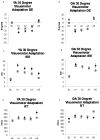Age differences in spatial working memory contributions to visuomotor adaptation and transfer
- PMID: 21784106
- PMCID: PMC3170505
- DOI: 10.1016/j.bbr.2011.07.014
Age differences in spatial working memory contributions to visuomotor adaptation and transfer
Abstract
Throughout our life span we encounter challenges that require us to adapt to the demands of our changing environment; this entails learning new skills. Two primary components of motor skill learning are motor acquisition, the initial process of learning the skill, and motor transfer, when learning a new skill is benefitted by the overlap with a previously learned one. Older adults typically exhibit declines in motor acquisition compared to young adults, but remarkably, do not demonstrate deficits in motor transfer [10]. Our recent work demonstrates that a failure to engage spatial working memory (SWM) is associated with skill learning deficits in older adults [16]. Here, we investigate the role that SWM plays in both motor learning and transfer in young and older adults. Both age groups exhibited performance savings, or positive transfer, at transfer of learning for some performance variables. Measures of spatial working memory performance and reaction time correlated with both motor learning and transfer for young adults. Young adults recruited overlapping brain regions in prefrontal, premotor, parietal and occipital cortex for performance of a SWM and a visuomotor adaptation task, most notably during motor learning, replicating our prior findings [12]. Neural overlap between the SWM task and visuomotor adaptation for the older adults was limited to parietal cortex, with minimal changes from motor learning to transfer. Combined, these results suggest that age differences in engagement of cognitive strategies have a differential impact on motor learning and transfer.
Copyright © 2011 Elsevier B.V. All rights reserved.
Figures






References
-
- Anguera JA, Reuter-Lorenz PA, Willingham DT, Seidler RD. Failure to engage spatial working memory contributes to age-related declines in visuomotor learning. J Cog Neuro. 2011;23:11–25. - PubMed
-
- Anguera JA, Reuter-Lorenz PA, Willingham DT, Seidler RD. Contributions of spatial working memory to visuomotor learning. J Cog Neuro. 2010;22:1917–30. - PubMed
-
- Ruch F. The differentiative effects of age upon human learning. Journal of General Psychology. 1934;11:261–286.
-
- Harrington DL, Haaland KY. Skill learning in the elderly- diminished implicit and explicit memory for a motor sequence. Psych Aging. 1992;7:425–434. - PubMed
Publication types
MeSH terms
Substances
Grants and funding
LinkOut - more resources
Full Text Sources
Medical

